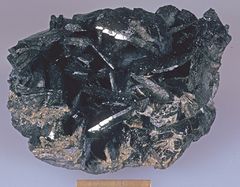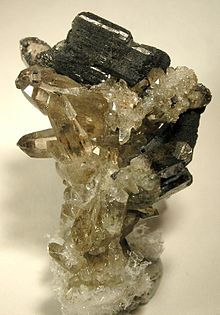- Allanite
-
Allanite 
Allanite from the Mt. Isa – Cloncurry area, Queensland, Australia (scale bar 1 inch)General Category Silicate mineral Chemical formula (Ce,Ca,Y,La)2(Al,Fe+3)3(SiO4)3(OH) Crystal symmetry Monoclinic 2/m Unit cell a = 8.927 Å, b = 5.761 Å, c = 10.15 Å; β = 114.77°; Z = 2 Identification Color Brown to black Crystal habit Crystals tabular, prismatic to acicular; granular, massive; commonly metamict Crystal system Monoclinic Twinning Polysynthetic, common on {100} Cleavage Imperfect to poor Fracture Conchoidal to uneven Tenacity Brittle Mohs scale hardness 5.5–6 Luster Vitreous, resinous to submetallic Streak Grey Diaphaneity Translucent to opaque Specific gravity 3.5 – 4.2 Optical properties Biaxial (-) Refractive index nα = 1.715–1.791, nβ = 1.718–1.815, nγ = 1.733–1.822 Birefringence δ = 0.018–0.031 Pleochroism X = pale olive-green, reddish brown;
Y = dark brown, brownish yellow;
Z = dark reddish brown, greenish brown2V angle Measured: 40° to 80° Dispersion r > v; strong Other characteristics May be radioactive References [1][2][3] Allanite is a sorosilicate group of minerals within the broader epidote group that contain a significant amount of rare earth elements. The mineral occurs mainly in metamorphosed clay rich sediments and felsic igneous rocks. It has the general formula A2M3Si3O12[OH] where the A sites can contain large cations such as Ca2+, Sr2+, and rare earth elements and the M sites admit Al3+, Fe3+, Mn3+, Fe2+, or Mg2+ among others[4]. However, a large amount of additional elements, including Th, U, Zr, P, Ba, Cr and others may be present in the mineral. The International Mineralogical Association lists three minerals in the allanite group, each recognized as a unique mineral: allanite-(Ce), allanite-(La) and allanite-(Y), depending on the dominant rare earth present, cerium, lanthanum or yttrium.
Allanite, also called orthite, contains up to 20% rare earth elements and is a valuable source of them. The inclusion of thorium and other radioactive elements in allanite results in some interesting phenomena. Allanite often has a pleochroic halo of radiation damage in the minerals immediately adjacent. Also highly radioactive grains of allanite often have their structure disrupted or are metamict. The age of allanite grains that have not been destroyed by radiation can be determined using different techniques.[5]
Allanite is usually black in color, but can be brown, brown-violet. It is often coated with a yellow-brown alertation product,[6] likely limonite. It crystallizes in the monoclinic system and forms prismatic crystals. It has a Mohs hardness of 5.5–6 and a specific gravity of 3.5–4.2. It is also pyrognomic, meaning that it becomes incandescent at a relatively low temperature of about 95 °C.
It was discovered in 1810 and named for the Scottish mineralogist, Thomas Allan (1777–1833).[1] The type locality is Aluk Island, Greenland[2] where it was first discovered by Karl Ludwig Giesecke.
References
- ^ a b Allanite-(Ce). Handbook of Mineralogy
- ^ a b Allanite. Mindat.org
- ^ Allanite. Webmineral
- ^ Dollase, W.A. (1971). "Refinement of the crystal structure of epidote, allanite, and hancockite". American Mineralogist, 56: 447–464. http://rruff.info/uploads/AM56_447.pdf.
- ^ Catlos, E.J., Sorensen, S.S., Harrison, T.M. (2000). "Th-Pb ion-microprobe dating of allanite". American Mineralogist 85: 633–648. http://sims.ess.ucla.edu/PDF/catlos_et_al_AMMIN_2000.pdf.
- ^ Klein, C., Dutrow, B. (2007) Manual of Mineral Science. Wiley Publishers, p. 500
Categories:- Calcium minerals
- Lanthanide minerals
- Yttrium minerals
- Aluminium minerals
- Iron minerals
- Epidote group
- Monoclinic minerals
Wikimedia Foundation. 2010.

